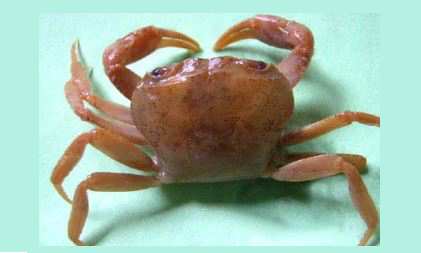Scientific Name: Austrotelphusa transversa (von Martens, 1868)
Synonym: Thelphusa transversa (Currently unaccepted)
English Name: Freshwater Land Crab
Local/Bangla Name: Kakra (কাঁকড়া)
Classification:
Kingdom: Animalia
Phylum: Arthropoda
Class: Malacostraca
Order: Decapoda
Family: Gecarcinucidae
Description:
The carapace of this species is subovate, conspicuously swollen, and exhibits a distinct gastro-cardiac groove, with sharp epigastric and postorbital cristae. There are no setae or carinae present. The outer epibranchial, meta- and mesobranchial regions show faint, obliquely placed carinae. A distinct H-shaped gastric groove is located near the center of the carapace. The antero- and posterolateral margins are well-defined, with the anterolateral margin typically prominently convex and lacking prominent epibranchial teeth on the lateral margins. A flat but faint projection is observed below the orbital spine. The eye socket and eye stock are of moderate size, and the outer margin of the orbit is U to V-shaped. Both sexes have equal chelipeds, which are moderately long, broad, and swollen, without compression but robust and stout. The carpal process is acute and moderately large, with two lobes on the outer margin of the carpus. Pereiopods are long, thin, and laterally compressed, with the third pereiopod being larger than the others, and the merus and dactylus of the third pereiopod are larger than those of the others. The fifth pereiopod is shorter than the others. Both the upper and lower margins of the propodus and dactylus are setose, and the dorsal and ventral margins of the dactylus have spinules. The dactylus is long and styliform, and an epigastric crest is present. The abdomen has seven free segments, with the male abdomen appearing sub-triangular to distinctly inverted T-shaped, with the last 3-4 segments being very narrow, especially the distal segments, which are broader and less elongated. The male first gonopod is well chitinous with terminal and sub-terminal segments, while the second gonopod is relatively short, rarely longer than half the length of the first gonopod. The mandibular palp is 3-segmented, with the terminal segment clearly bilobed, one lobe slightly smaller than the other. Antennae and antennules are of moderate size. In terms of coloration, the dorsal surface of the carapace and cheliped is greenish-yellow, while the outer surface of the cheliped is light-brown. The ventral surface of the cheliped, pereiopod, and carapace is yellowish-brown. The dorsal surface is pale pink with red, appearing smooth with minute patches of brown spots, and the abdomen is light-colored. The dorsal surface of the carpus, propodus, and proximal margin of the merus exhibit reddish-brown (in young individuals) or brown spots. In terms of size, the male carapace measures about 30-35 mm in length and 38-43 mm in width, while the female carapace measures about 28-32 mm in length and 35-39 mm in width.
Habitat & Distribution in Bangladesh:
Found on freshwater bodies such as rivers, swamps, beels, canals, etc and occasionally, farm dams and paddy fields during summer. A newly recorded crab species for the first time in Manikgonj area of Bangladesh.
Environment:
Freshwater
References:
Ahmed ATA, Kabir SMH, Ahmad M, Rahman AKA, Haque EU, Ahmed ZU, Begum ZNT, Hassan MA, Khondker M (2008) Encyclopedia of Flora and Fauna of Bangladesh, Vol. 18. Part II Arthropoda: Crustacea. Asiatic Society of Bangladesh, Dhaka 226 pp








